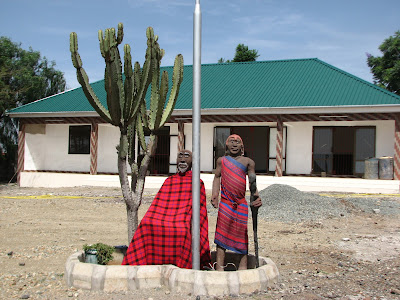We headed back out toward Monduli. We've visited twice before (which you can read about here and here). This time we drove through Monduli, and Monduli Juu and dropped over the top of the ridge and down into the Great Rift Valley.
The wind was so strong, it was pushing the car sideways. We stopped at a petrol station to check the tires, just to be sure the pressure was good all the way around.
Finally, I can take a picture of someone wearing Maasai shuka and they won't mind...even if they are just statues decorating the petrol station.
We'd left home, as usual, with no planning ahead and thus no food in the car. When we reached the little town of Monduli, it was about an hour before lunch time, but we couldn't expect to buy food past this point. We weren't too sure we could buy food at this point. But after driving through the streets, we found a small pub where the owner cooked barbecued goat for us. One more meal in a small, very local-style place that didn't look too clean. And once more the food was very good and I didn't get sick.
Then on up into the hills and on to Monduli Juu. The flat-topped acacias were blooming.
They're the white ones scattered through the forest.
I think they're flat-topped acacias. But I'm not sure, because the site seems wrong; they're usually in dry savanna sites. I keep wishing I'd bought the East African trees field guide I saw awhile back, but it was about $60 U.S., so I passed.
Heading down into the Great Rift Valley, we had a hazy view of Mt. Meru. The air was full of dust.
On the valley floor.
Swarms of dust devils were blowing around.
We saw a few scattered Maasai villages away from the road.
And a few bands of goats with young Maasai herd boys watching them from a distance.
Dry dry dry! But with a water system. We saw this big tank and a few small metal boxes here and there that we speculated were access points for water.
And the goats are off in a cloud of dust!
I love acacias.
The hanging balls of grass are weaver bird nests.
Five of these gerenuk were bounding through the brush. This was my first time to see this long-necked, skinny antelope. The western end of the Great Rift Valley is at the end of its range (according to the Audubon Society field guide).
We made the drive home with the wind still buffeting the car, but of course, pushing us in the other direction, so we finally realized it wasn't the tire pressure. Duh!
A couple of weeks later, Shanette (travel companion for a weekend at the beach and surgeon extraordinaire in an ugly parasitic sandflea incident) and I took a short hike around Lake Duluti, a small lake about 30 minutes drive from Arusha. K2 and I visited Lake Duluti awhile back, but we were feeling too lazy to make the shoreline hike at the time. This time, it was only a couple of hours after Shanette cut out the jigger egg case from the side of my big toe, and I tied my hiking boots on and walked six kilometers (easy ones, I have to admit).
Lake Duluti and the ubiquitous Mt. Meru
The nearby small town of Tengeru (I think Antonio said it's Tengeru) draws its water supply from the lake. So there's no swimming allowed. Although you can rent canoes. Maybe we'll try that next time.
Who's Antonio? He's the Park Ranger who guided us on the trail around the lake, pictured here with Shanette. He really knows his birds, and where the monitor lizards bask, and he made the hike more fun.
Egret and cormorants.
The bundle of grass hanging from the reeds on the right is a weaver bird nest.
These huge spider webs hung in several trees. Antonio called them "community spiders," because each web is built by a whole colony of spiders.
We continued our stroll along the shore. I was telling Antonio the animal I most hoped to see was...
...the Nile Monitor Lizard! This one was basking on a log right off the shoreline.
We walked a bit farther...
...and found a second Nile Monitor. Antonio knew right where to look.
On around the shoreline a bit further...
...where we saw these two African fish eagles perched above the lake.
Antonio pointed out this owl tucked away deep inside a tree's canopy for the day. He didn't say what species. I tried to find K2's bird field guide, but the book has disappeared. When I asked K2, he said he'd taken it on a trek and forgot to bring it back. It took me about 5 months to get him to remember to bring it to me from his place, then I used it for about 3 months, and now it's gone again! At least I still have the field guide with the antelope in it so I could identify the gerenuk.
Exciting update added March 5: Hey, I bought my own field guide to birds and it's a good one. I am now identifying this bird as a Pearl-Spotted Owlet.
African drumming accompanied us on about the last kilometer of the walk. When we reached Lake Duluti Forest Club, we saw this crew filming a movie. Looks like some sort of historic epic. Or more likely, a cheesy soap opera with a historic setting.
It was a lovely hike, with a high concentration of interesting birds and animals. I'll have to keep a watch for the upcoming movie filmed on the shores of Lake Duluti.









































No comments:
Post a Comment